‘Coherence’: Paul’s ART STUFF ON A TRAIN #200 DJ Roberts chose Philippe Halsman’s unusual 1952 image of Marilyn Monroe to allude to Larkin’s interests in certain areas of glamour and pornography Art and poetry don’t always cohere, but two events this week have shown how to bring them together. On Tuesday artist DJ Roberts opened an installation paying tribute to Philip Larkin (Larkinworld, at the Poetry Library in the Royal Festival Hall to 16 April), an eclectic and appropriately modest mixture of chances to hear poems with evocations of the poet’s character and concerns, from vinyl posters of his little-known jazz lyrics to the books he read, records he listened to and photographs of people he admired. Roberts himself contributes small drawings of Hull and the noen ‘Like an enormous yes’, highlighting his thesis that Larkin should be taken more optimistically than is the norm, hence his concentration on Larkin’s humour and enthusiasms rather than the curmudgeonly poses he loved to strike. On Wednesday, Heather Phillipson gave an illustrated talk about her own work (as part of the Zabludowicz Collection’s admirable ‘master class’ series). She didn’t read any of her award-winning poetry, but it lay behind at every point in her dazzlingly erudite account of the way she has expanded their concerns into a stream of major art installations all over the world. Where Roberts is self-effacing, Phillipson is ambitious, colliding academic theory, poetic language, fear, fantasy, politics and a deep concern for human-animal relations as issue and metaphor. If any coherence is hard to grasp, that’s the messiness of the world. ‘Why live simply’, she asked teasingly, ‘when it’s so easy to make things complicated?’.  Heather Phillipson: THE END, shortlisted proposal for the Fourth Plinth, Trafalgar Square, on view at the National Gallery, London, 19th January – 27 March 2017 / image credit: James O Jenkins ‘Homage to the Homages’ : Paul’s ART STUFF ON A TRAIN #199
Josef Albers: ‘Study for Homage to the Square [Autumn Scent]’, 1966 – Oil on Masonite, 41.3 x 41.3 cm)
It’s easy to be blasé about Albers’ Homage to a Square series, which occupied him pretty much exclusively from 1950-76. Yes, they’re canonical, but we know what to expect: three or four nested squares in multiple colour variations within a narrow band of visible white ground. In isolation – as they’re often seen – they can look like just ‘another one of those’ to walk past. But you’re forced to look more closely by a show of forty predominantly yellow works and studies (Josef Albers: ‘Sunny Side Up’ at David Zwirner to 10 March, all sourced from the Josef and Anni Albers Foundation). Different palettes create different climates, according to Albers, and Zwirner-goers in New York get the bleaker weather of his grey and black works, whereas in London ‘all is sweet / on the sunny side of the street’. That although Albers’ basic method is rather clinical and cold: unmixed colours (he was a fanatical purchaser of paint) squeezed straight from the tube onto Masonite. Yet the variations in scale are impactful – the four foot square example here is the biggest I’ve seen – as is the demonstration of how different dynamics can come out of a relatively narrow colour range. That includes shifts in the dominant spatial perception: do we read the squares as flat, or as a tunnel ahead, or as the aerial view of a stack? It’s often said that one test of art’s impact is whether you see the world differently afterwards: it’s a rather trivial example, but within twenty yards of leaving the show, the pavement didn’t look as it did before…
The pavement on Grafton Street near David Zwirner
Most days art Critic Paul Carey-Kent spends hours on the train, traveling between his home in Southampton and his day job in London. Could he, we asked, jot down whatever came into his head?
‘The Case for Swindon’: Paul’s ART STUFF ON A TRAIN #198
John Hoyland: ‘Trickster’, 8.12.77. Acrylic on canvas. 90 x 84 inches
Whenever my wife and I drive to the west country, Swindon provides a convenient halfway break for coffee – except that it’s a standing joke between us that she always wants to stop somewhere else. Perhaps it’s not the most alluring place , though the old town is nice enough, but a good reason to stop off has recently come to my attention: the local Museum and Gallery’s excellent and cunningly acquired collection of modern British art. Moreover (to 11 Feb), you don’t have to go to Swindon to see a good sample from it, as Osbourne Samuel are showing highlights including Alfred Wallis, Ben Nicholson, Lucien Freud, Richard Hamilton, William Turnbull and Gillian Ayres. To pick one, ‘Trickster’, 1977 must be as fine a painting as John Hoyland ever produced. Nor is the collection static: the London showing is designed to publicise its fund-raising case for expanding into a new building; and in September it is the venue for a solo show which was part of Cathy Lomax’s prize for winning the British Contemporary Painting Prize in 2016. So, worth a visit – and that also provides a chance to mention that Lomax, who is one of the directors of the artist-run Transition Gallery in Hackney, will also feature in ‘Ears For The Eyes’, my own rather eccentric show at Transition Gallery (10 Feb – 5 March). If you’re not stuck in Swindon at the time, I recommend it.
Cathy Lomax: ‘Audrey’s Ear’, 2016
‘Padding Up’: Paul’s ART STUFF ON A TRAIN #197 Francis Bacon: ‘Study for the Human Body’, 1982  Dan Rees: ‘French Cricket’, 2010 – installation view at Tanya Leighton Gallery, Berlin
Were there an Olympics for sports and games in art, I could imagine table tennis, chess and football as medallists. Cricket is a rarer presence, partly I suppose due to its limited geographical scope, so the yet narrower history of cricket pads in art, rather than mere genre paintings or celebratory statues of cricketers wearing them, is less than extensive. Francis Bacon employed them in several 80’s paintings as a means of further alienating the distorted body even as they might pretend to protect it. ‘French Cricket’, Welsh artist Dan Rees’ 2010 show in Berlin, included graffiti-sprayed pads in a gentlemen-meet-the-street moment. Perhaps, rather than conjuring up the trivial, stumpless version of the game as typically played on the beach, Res’ version operates like French bread or French kisses, which are surely better than plain bread or kisses. And just recently pads formed an ideal foil for considerations of colonialism and protection in Oxford-based South African painter Carla Basuttil’s show at Josh Lilley (Nov – Dec 2016). For ‘The Super-Suburb Defence Authority’ she invented her own private security company (in Johannesburg, it’s a bigger business than policing). A mock film advert for the firm featured men wearing painted masks, some of them in the form of cricket pads. And those pads were also shown sculpturally under a title with both cricket and non-cricket meanings: ‘Nightwatchmen’.
 Carla Basuttil: Nightwatchman 3, 2016  Carla Basuttil: still from ‘Defending Your Territory’, 2016 ‘Mind the Gap!’: Paul’s ART STUFF ON A TRAIN #196
Installation view of Les Lalannes at Ben Brown Fine Art, London
Ah no, not the gap between train and platform, or between supposed rail service and practical reality over Chistmas. The gap between art and design can be hard to pin down. Two current shows pose the question by combining the two Ben Brown (to 26 Jan) has a spectacular installation of Claude and François-Xavier Lalanne’s animal-based furniture and less functional objects, complete with pool and set against photographic backdrops. The show includes a fireplace in the form of a baboon, a flock of sheep of doubtful functionality (with just a couple cut back to definite seathood), vine-encircled mirrors and aluminium crocodile skins you can sit on – plus their famous cabbage with chicken legs. Les Laannes worked together from 1956 until François died in 2008, but Claude is still producing at 93. The rather younger London-based Nigerian Mimi Shodeinde trained as an architect, which may be the right background for combining painting and furniture design. Her leather and plexiglass chairs are curvaceously modernist, while the paintings take more direct inspiration from the female form. They are from a series entitled ‘Iwa’ – ‘character’ in Yoruba- but are as visage-free as the chairs, as Shodeinde considers the face too distracting. Their gold and black scheme is textured with tissue paper, sand and salt to stop them getting too smooth and kitsch: richness and roughness are juxtaposed. Again, the total environment is effective (at the Gallery of African Art to 21 Jan), especially against dark grey – however much is design and how much art.
Mimi Shodeinde in the Gallery of African Art, 45 Albemarle Street, London
Most days art Critic Paul Carey-Kent spends hours on the train, traveling between his home in Southampton and his day job in London. Could he, we asked, jot down whatever came into his head?
‘Art for Health?’ Paul’s ART STUFF ON A TRAIN #195
Cornelia Baltes ‘Hanging Out Again’, 2014 – Wood, Pine veneer, Cherry Wood veneer, American Walnut veneer, paint – Royal London Hospital Maternity Unit
My two worlds – art and health
finance – rarely cross, so it was doubly interesting to be shown around some of
the art commissioned by www.vitalarts.org.uk in the hospitals of the Barts Health
NHS Trust – England’s biggest. The Trust doesn't pay for the art, but Director Catsou Roberts has done an impressive
job seeking external funds to enable artists to make work
for clinical settings. The highlights of a 2,000-strong collection include
Cornelia Baltes’ wooden birds, Roger Hiorns’ copper sulphate stoppages of
discarded office clocks from The Old Royal London Hospital, and striking work
by Peter Liversidge, Hurvin Anderson, Richard Slee and Kim Rugg. Roberts gets
plenty of positive feedback, but can art be proven good Value for Money in the
cash-strapped NHS? Perhaps, in that a collection valued at £2m has been
leveraged out of a budget of £100,000 per year for the art team which also runs music, dance and craft
workshops across five hospitals. That represents just 4p per head
of the 2.5m population served and a mere pinprick against Barts’ total annual
budget of £1.4bn. The art could help towards creating a positive environment,
which increases wellbeing and can speed recovery times. That's a good thing in
itself, of course - and when a hospital bed costs upwards of £300 per
day, it takes only a tiny impact on length of stay across Barts’ 2,000-odd beds
to give a positive financial return. That sounds feasible, quite apart from
supporting the arts, which I naturally favour with my other hat on.
Roger Hiorns: ‘Untitled’, 2012 – found plastic and metal office clocks from the old Royal London Hospital and Copper sulphate Most days art Critic Paul Carey-Kent spends hours on the train, traveling between his home in Southampton and his day job in London. Could he, we asked, jot down whatever came into his head? ‘One Evening in London’: Paul’s ART STUFF ON A TRAIN # 194 |
Euan Uglow: ‘Daisy’, 1976
|

Martin Wilner: detail from subway drawing

Post-performance installation view of Mat Chivers: ‘Harmonic Distortion’
Most days art Critic Paul Carey-Kent spends hours on the train, traveling between his home in Southampton and his day job in London. Could he, we asked, jot down whatever came into his head?
Ryan_McGinley:’Marmoset LSD’, 2012

Linder’s dinner set
Studio Voltaire’s annual seasonal sale to benefit its work takes place (to 18 Dec) in the considerable central space of a knocked-through version of Alan Cristea’s former space on Cork Street. A visit is much more fun than the typical Christmas shopping experience, whether you buy or not. Christmas a la Voltaire seems to be more than usually oriented towards sex: Linda’s dinner set of porno-plates, a large green breast by Edward Kay, Ryan McGinley’s cheeky monkey and Cary Kwok’s drawing of a somewhat extravagant ejaculation are all prominent – but there’s plenty of other fun, too. Perhaps galleries in general are starting to take Christmas more seriously: Blain|Southern, for example, has a one day pop-up store and sale on 10 December. But if you’re given art, what will it look like at home? Arcade has a lively show which gives you an answer for Peggy Franck’s exuberantly colourful swirl paintings and tapestries, as not only is are they installed somewhat as if the gallery is a house, but ‘With no hands. Like a sea.’ (to 17 Dec) also incorporates photographs of the work in other spaces, so splicing documentation and art. Franck, it seems, hopes to pretty much take over your house, making her work a brave if adventurous gift! I guess you might opt for something more easily placed yet worthwhile – House of Voltaire have various towels and blankets, for example…
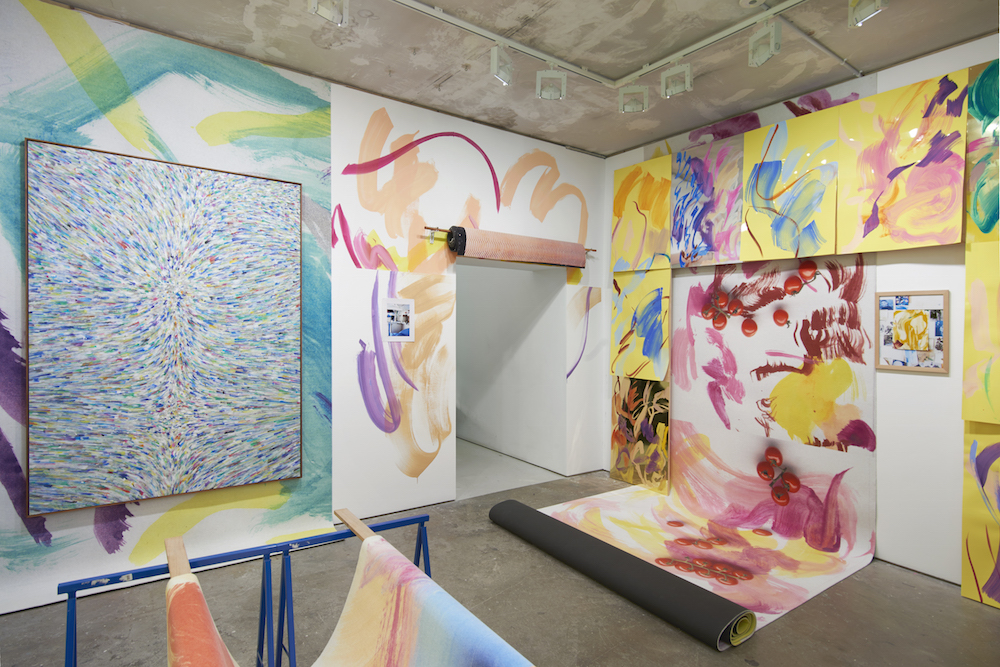
Peggy Franck install view at Arcade

Peggy Franck when you get the work home
Most days art Critic Paul Carey-Kent spends hours on the train, traveling between his home in Southampton and his day job in London. Could he, we asked, jot down whatever came into his head?
Most days art Critic Paul Carey-Kent spends hours on the train, traveling between his home in Southampton and his day job in London. Could he, we asked, jot down whatever came into his head?
‘All You Want for Christmas’: Paul’s ART STUFF ON A TRAIN #193
Ryan_McGinley:’Marmoset LSD’, 2012

Linder’s dinner set
Studio Voltaire’s annual seasonal sale to benefit its work takes place (to 18 Dec) in the considerable central space of a knocked-through version of Alan Cristea’s former space on Cork Street. A visit is much more fun than the typical Christmas shopping experience, whether you buy or not. Christmas a la Voltaire seems to be more than usually oriented towards sex: Linda’s dinner set of porno-plates, a large green breast by Edward Kay, Ryan McGinley’s cheeky monkey and Cary Kwok’s drawing of a somewhat extravagant ejaculation are all prominent – but there’s plenty of other fun, too. Perhaps galleries in general are starting to take Christmas more seriously: Blain|Southern, for example, has a one day pop-up store and sale on 10 December. But if you’re given art, what will it look like at home? Arcade has a lively show which gives you an answer for Peggy Franck’s exuberantly colourful swirl paintings and tapestries, as not only is are they installed somewhat as if the gallery is a house, but ‘With no hands. Like a sea.’ (to 17 Dec) also incorporates photographs of the work in other spaces, so splicing documentation and art. Franck, it seems, hopes to pretty much take over your house, making her work a brave if adventurous gift! I guess you might opt for something more easily placed yet worthwhile – House of Voltaire have various towels and blankets, for example…

Peggy Franck install view at Arcade

Peggy Franck when you get the work home
Most days art Critic Paul Carey-Kent spends hours on the train, traveling between his home in Southampton and his day job in London. Could he, we asked, jot down whatever came into his head?
‘Not What But Whose’: Paul’s ART STUFF ON A TRAIN #192
Patrick Hughes: ‘Liquorice Allsorts’, 1960 – Estimate in Bowie sale £10—15,000, sold at £81,250
Whilst provenance is an important factor in establishing the genuineness of work for valuation purposes, it isn’t normally a big factor in exhibitions. Just recently, though, three quite different exhibitions have had that focus. Sotheby’s, leading up to their 10 Nov auction, showed David Bowie’s art and design collection. It was packed, and catalogue sales were brisk – something which was hard to attribute to the public taste for such as Bryan Wynter, Bernard Leach and Ettore Sottsass – and the auction yielded prices which were typically double estimate. The Tate’s big new photography show (‘The Radical Eye’ to 7 May) is also part celebrity snooping, as while the quality of Sir Elton John’s 10,000 work photography collection is not to be doubted, it is presented in ways designed to let us see what John’s massive Atlanta house looks like, smothered as it is in his collection mounted in floridly assertive frames. In a contrast of sorts, Annely Juda is showing the bulk of a modest yet thoughtfully compiled collection of 56 works by former art critic Jos Knaepen (1933 – 2014) – it’s quietly good yet has of course got no attention. The Knaepen Collection – A Passion for Art (to 23 December) does, though, have its own focus on provenance, as a large proportion of the work was bought from Annely Juda…

Installation view of Sir Elton John’s frames
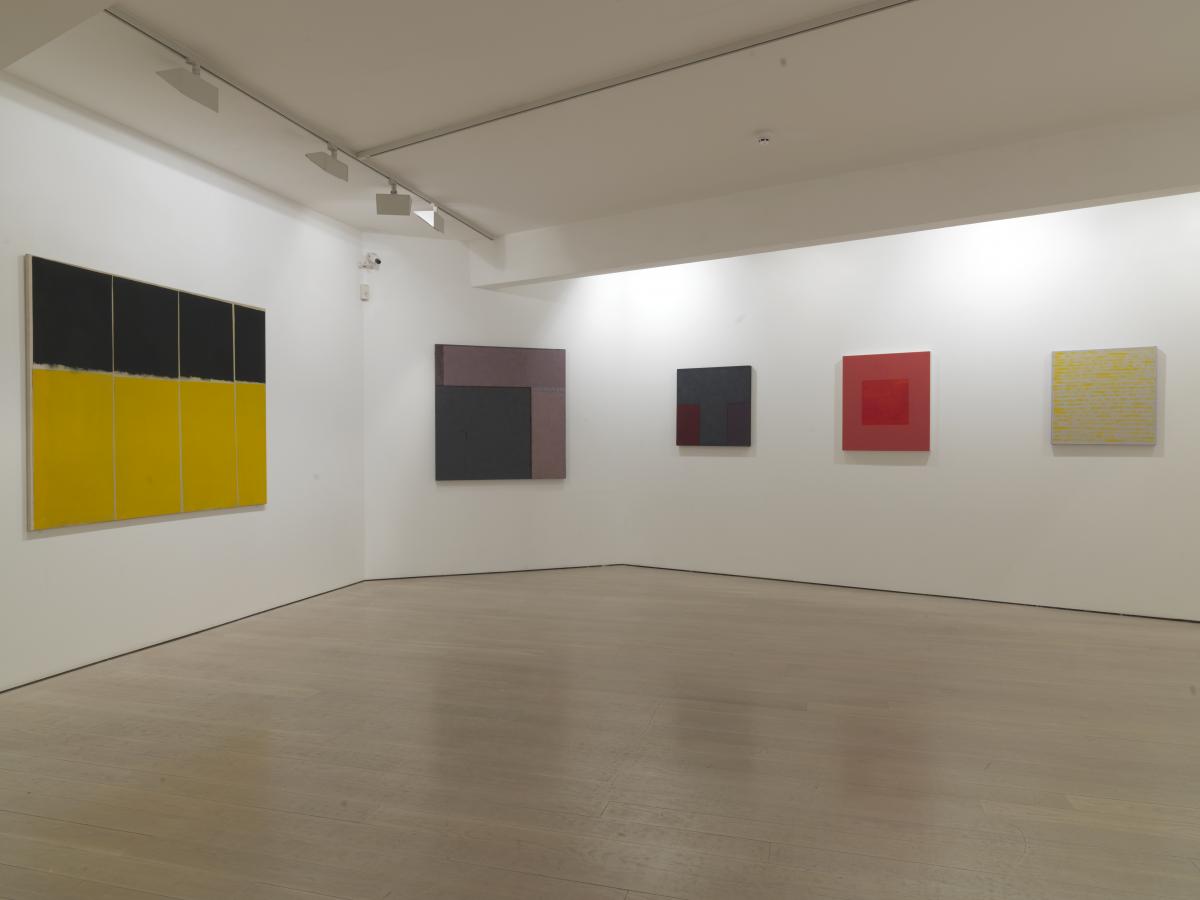
Installation view of The Knaepen Collection, with Alan Green, Joseph Albers, Edwina Leapman
‘Shore Thing‘: Paul’s ART STUFF ON A TRAIN #190
Whilst provenance is an important factor in establishing the genuineness of work for valuation purposes, it isn’t normally a big factor in exhibitions. Just recently, though, three quite different exhibitions have had that focus. Sotheby’s, leading up to their 10 Nov auction, showed David Bowie’s art and design collection. It was packed, and catalogue sales were brisk – something which was hard to attribute to the public taste for such as Bryan Wynter, Bernard Leach and Ettore Sottsass – and the auction yielded prices which were typically double estimate. The Tate’s big new photography show (‘The Radical Eye’ to 7 May) is also part celebrity snooping, as while the quality of Sir Elton John’s 10,000 work photography collection is not to be doubted, it is presented in ways designed to let us see what John’s massive Atlanta house looks like, smothered as it is in his collection mounted in floridly assertive frames. In a contrast of sorts, Annely Juda is showing the bulk of a modest yet thoughtfully compiled collection of 56 works by former art critic Jos Knaepen (1933 – 2014) – it’s quietly good yet has of course got no attention. The Knaepen Collection – A Passion for Art (to 23 December) does, though, have its own focus on provenance, as a large proportion of the work was bought from Annely Juda…

Installation view of Sir Elton John’s frames

Installation view of The Knaepen Collection, with Alan Green, Joseph Albers, Edwina Leapman
‘Shore Thing‘: Paul’s ART STUFF ON A TRAIN #190
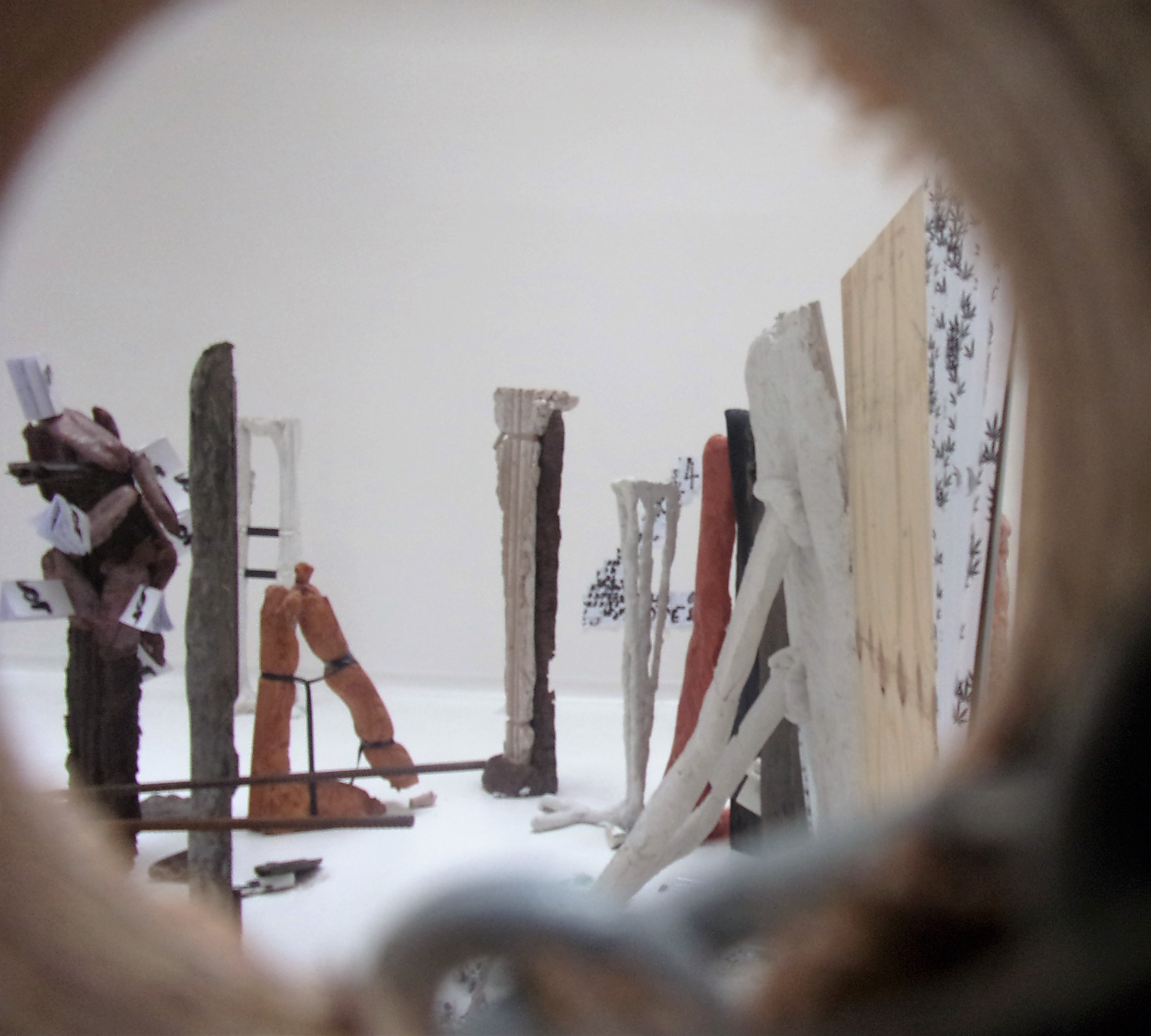
Michael Dean: installation view
The Turner Prize judges have a tough task this year (announcement 5 Dec). Should they recognise the originality of a sculptor who collapses language into body into cityscape with a formal zip which belies his primary material of utilitarian concrete? One, moreover, who was nominated for shows which a British-based art follower might well have seen (as I did, in Amsterdam and South London)? Or should they select one of the other comparatively ersatz artists – Anthea Hamilton, Helen Marten and Josephine Pryde – present on account of shows in America? Aren’t there, I wonder in passing, enough good shows in Britain? I’d be tempted to make the Turner a prize for the best show in Britain by an artist based here, in which case the shortlist would have seen Dean joined by, say, Jenett Thomas, Sara Barker and Magali Reus). Anyway, Michael Dean – for it is he who should win under actual or hypothetical rules – describes his aim as giving a hard core form to his writing, which he translates into into a typeface of his design, from which he then generates moulds and casts. Hence we can see abstract alphabets, crumpled pages and his self-published books (used as plinths, and from which he often invites the viewer to rip a page) as well as tongues and clenched fists. The prize, incidentally, is £25,000, only £4,564 more than Dean has included in ‘All shores describe touching’ in the form of a beach of 2,043,600 penny coins – which fits the sculptural mise–en–scène and speaks to what he calls ‘the industry of poverty’ – as the amount the Government states is needed to support a family of four.
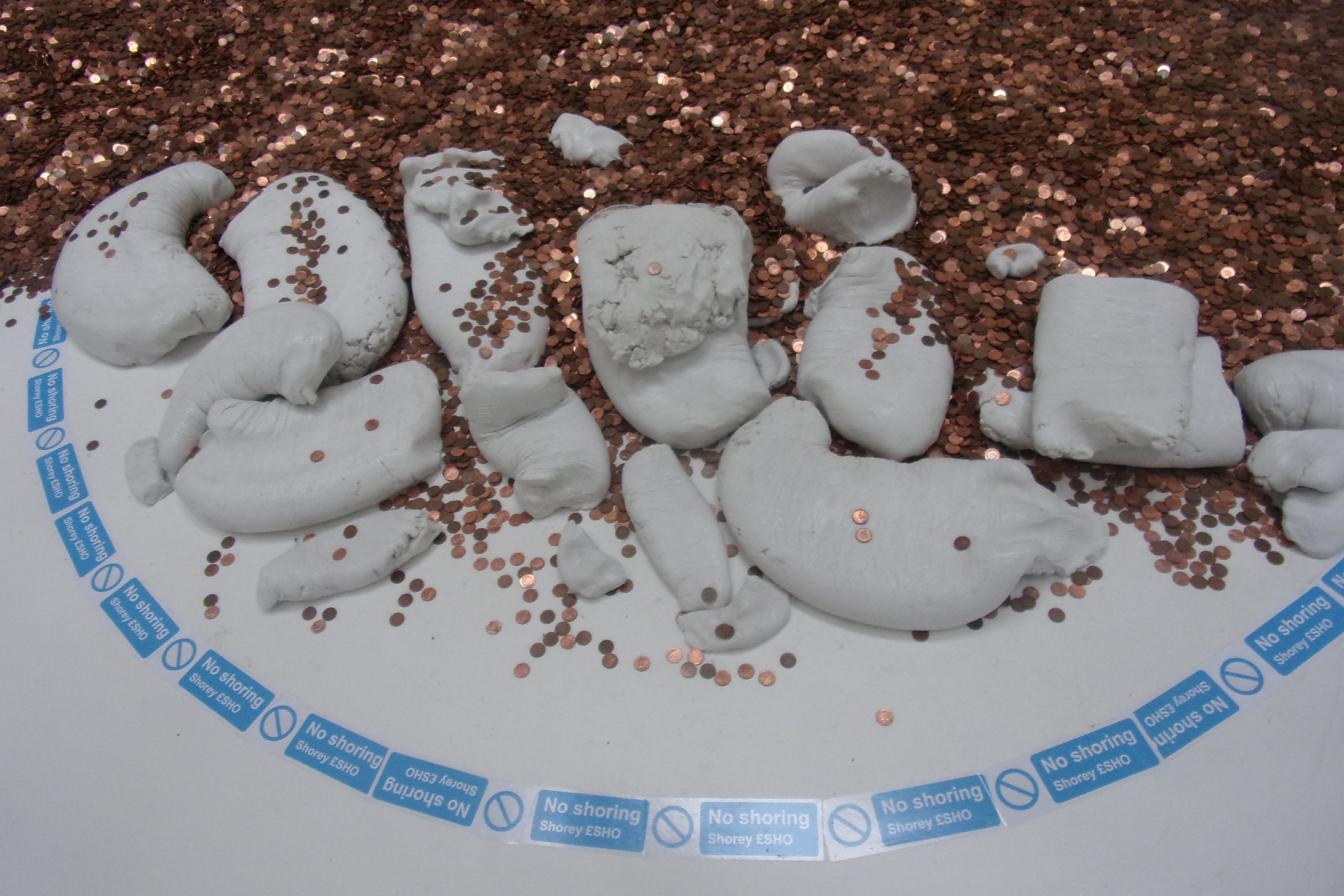
Michael Dean: installation view
Most days art Critic Paul Carey-Kent spends hours on the train, traveling between his home in Southampton and his day job in London. Could he, we asked, jot down whatever came into his head
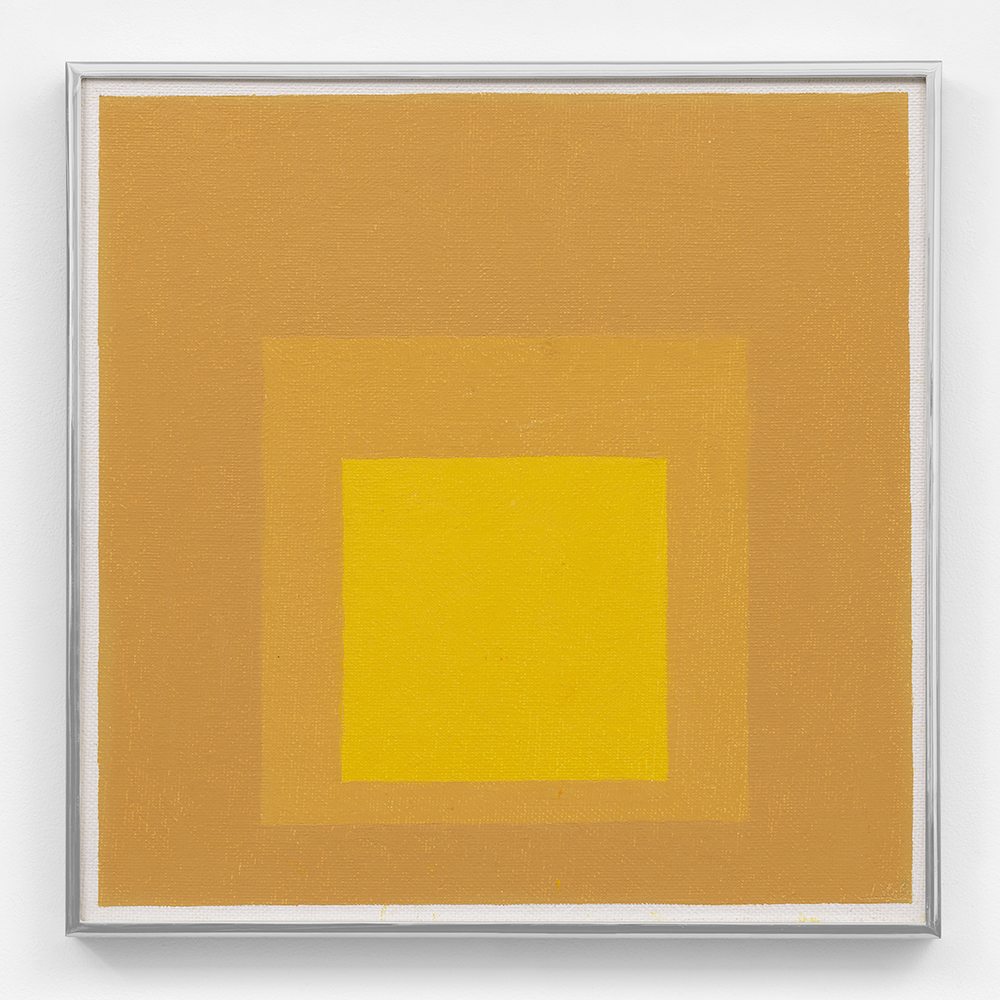
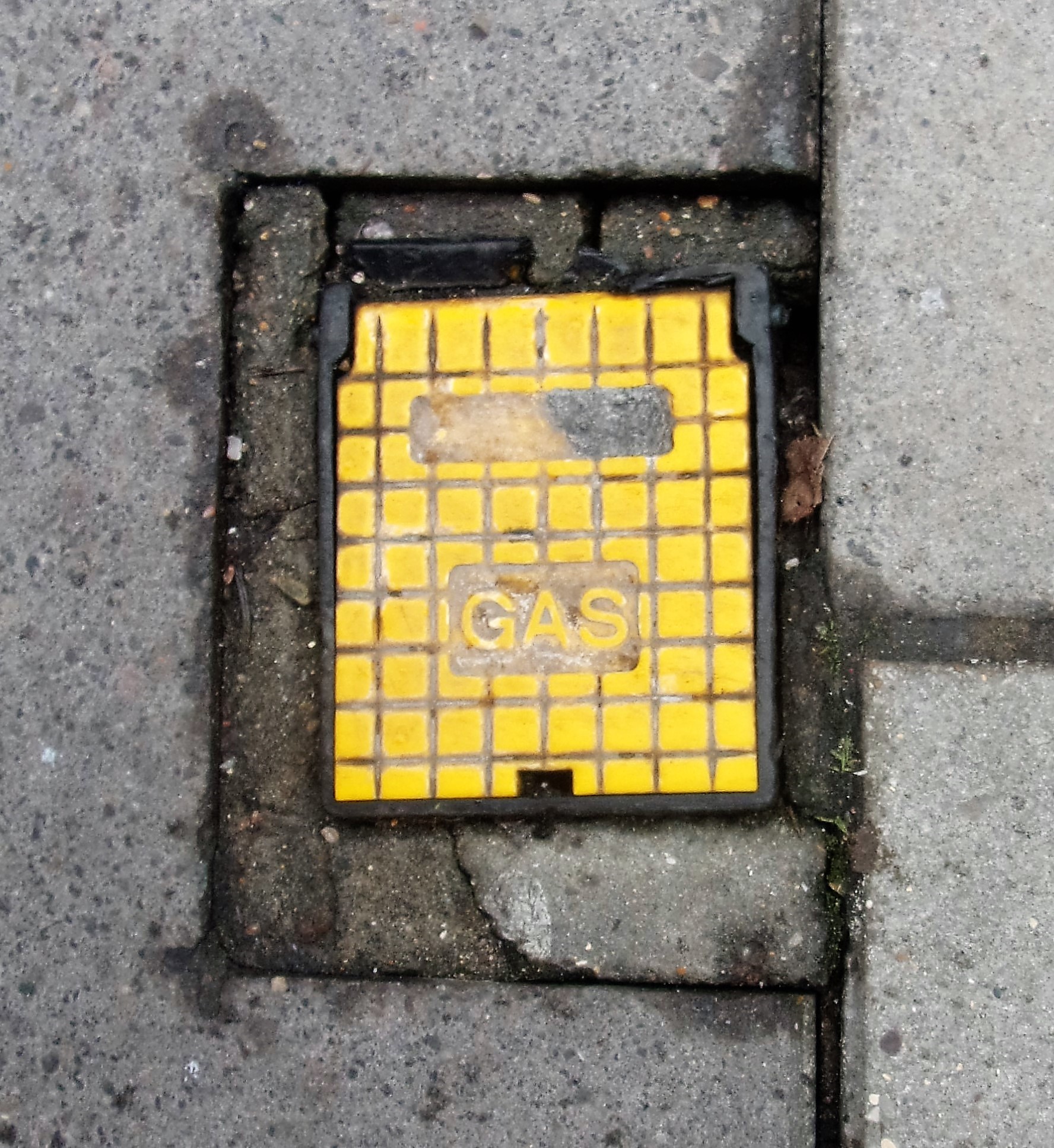




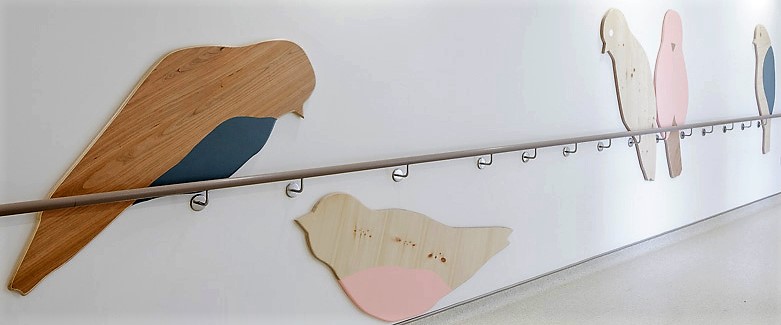
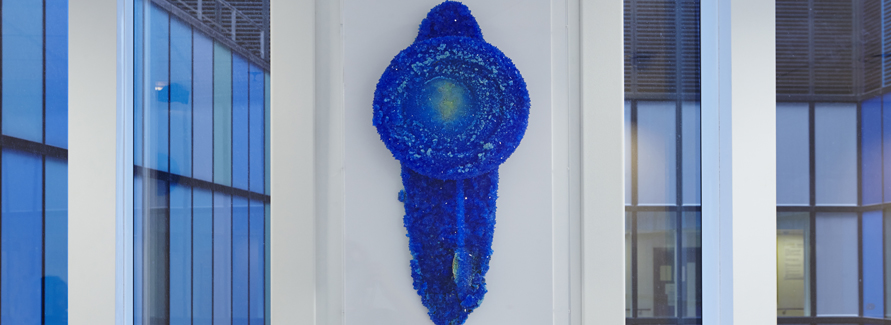

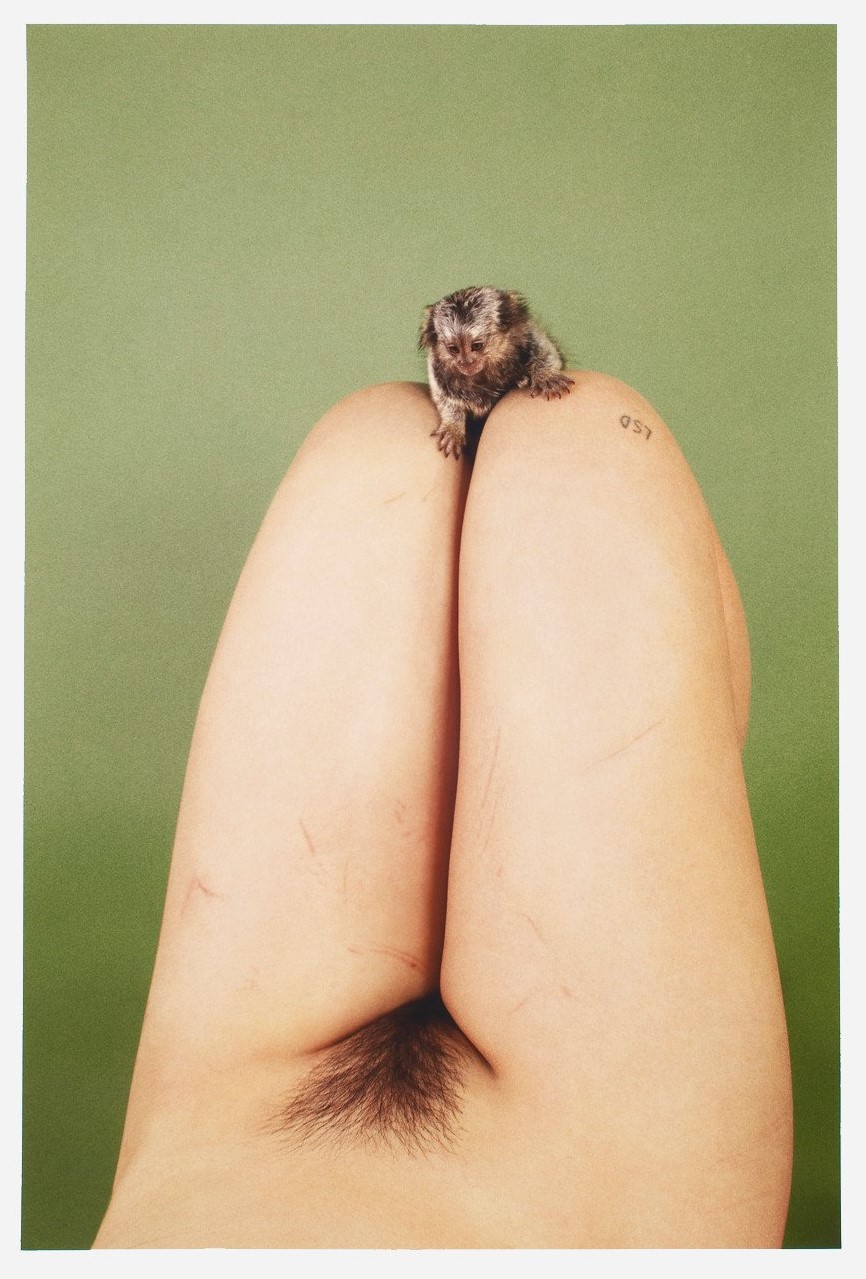
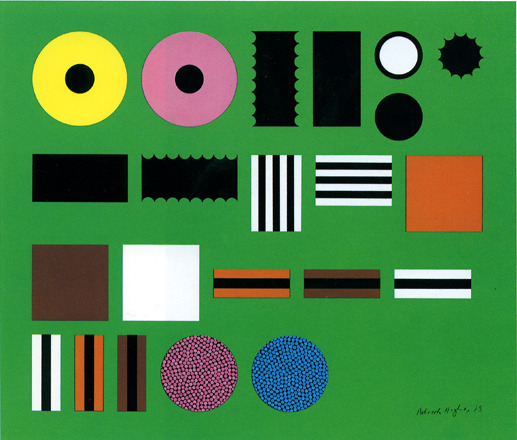

No comments:
Post a Comment
Note: only a member of this blog may post a comment.